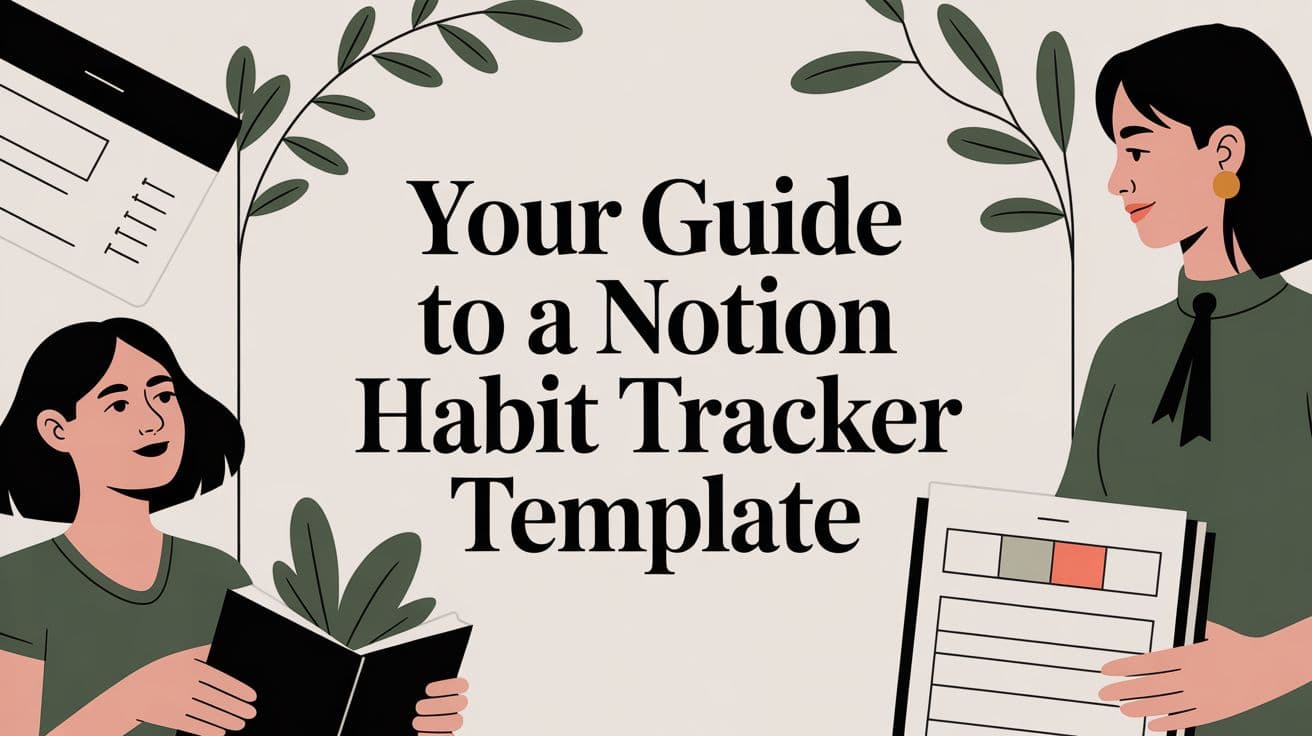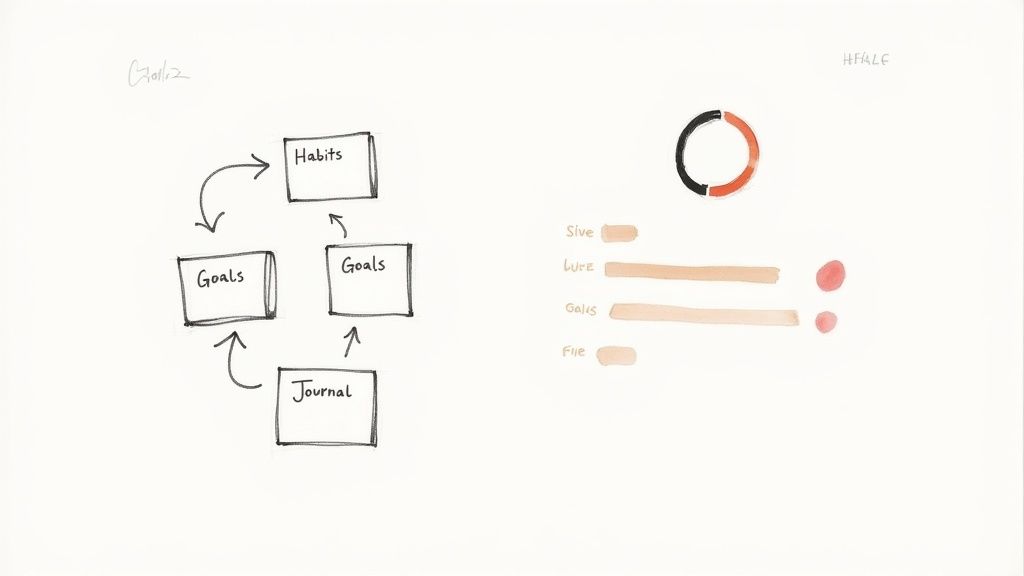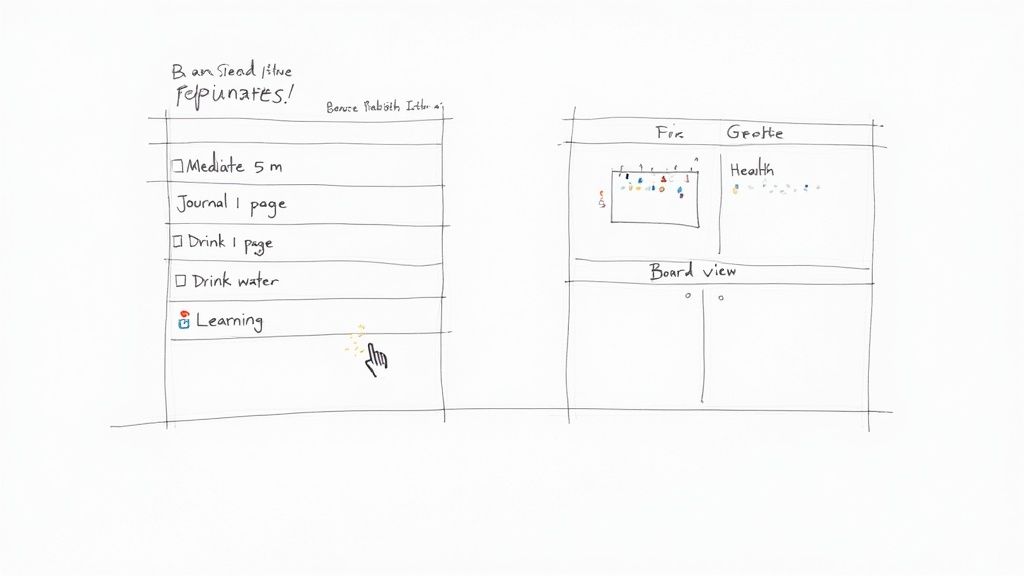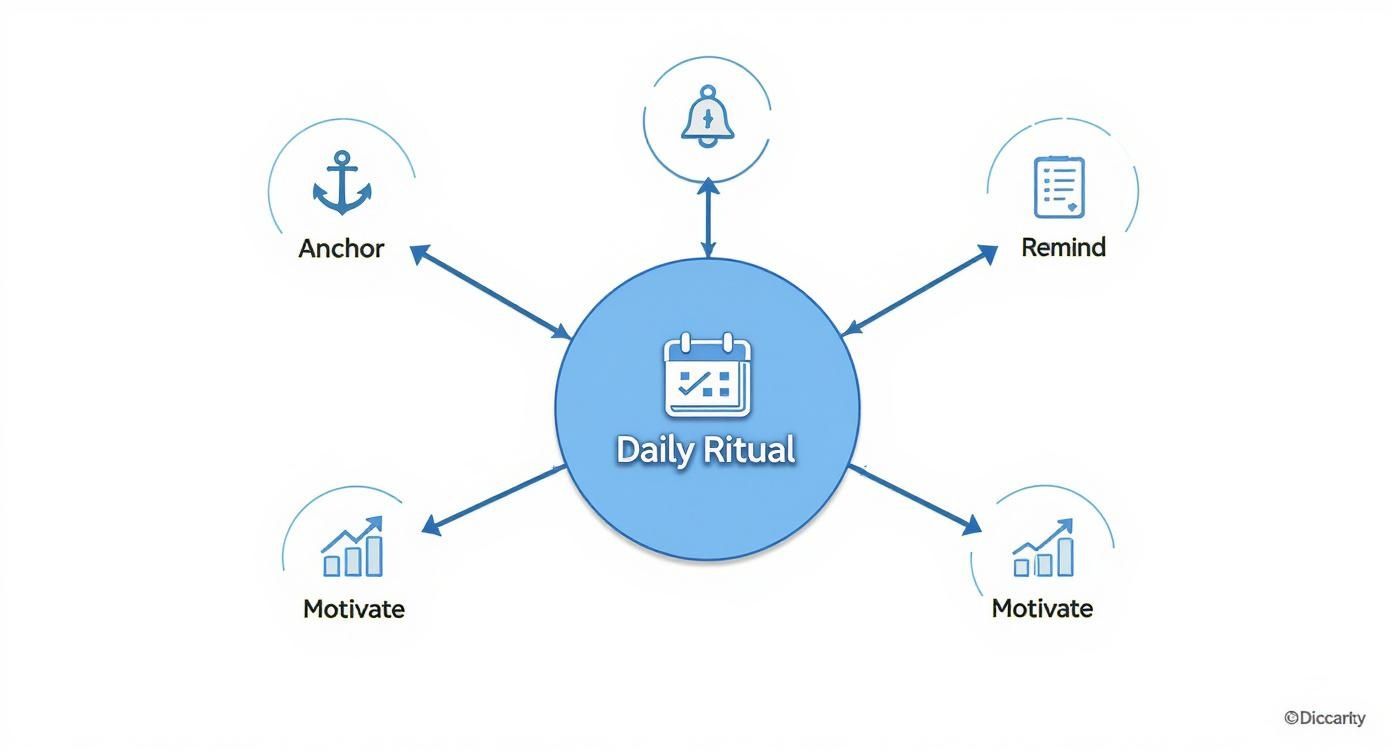
Your Guide to a Notion Habit Tracker Template
Discover how a Notion habit tracker template can transform your goals. Learn to find, customize, and master the perfect template for lasting change.
A Notion habit tracker template is essentially a pre-built dashboard inside your Notion workspace, designed specifically for tracking your habits. It’s far more than a simple to-do list; think of it as a smart system with progress bars, calendar views, and even data analysis to show you just how consistent you’re being.
Why Notion Is Your Secret Weapon for Consistency

Let's be real: a paper checklist feels great to tick off, but it's a dead end. It shows you what you did today, but offers zero insight into your long-term patterns or how those small daily actions connect to your bigger goals. This is exactly where a Notion habit tracker template completely changes the game.
Instead of a static list that gets tossed at the end of the week, Notion gives you a living, interconnected system. Imagine your habit tracker sitting right alongside your weekly goals, project plans, and daily journal entries. Suddenly, your scattered efforts become a unified strategy, all managed from one central command center for self-improvement.
Visual Feedback and Data-Driven Motivation
One of the biggest wins with a Notion setup is the power of visual feedback. There’s a special kind of motivation that comes from seeing a calendar fill up with green checkmarks or watching a progress bar inch closer to 100%. It’s a psychological boost that a simple piece of paper just can't deliver.
This visual proof of your commitment creates a powerful positive feedback loop, making you want to keep the streak alive.
And it’s not just a feeling; people genuinely find this effective. One popular template on the official marketplace, for example, boasts an average rating of 4.65/5 from over 1,000 users. A whopping 77% gave it a positive score, praising its blend of simplicity and customization for tracking everything from exercise to meditation. It’s clear these digital tools work.
Here’s a quick look at the core advantages a Notion-based habit tracker offers over traditional or other digital tools.
How a Notion Habit Tracker Beats Other Methods
| Feature | What It Means for You |
|---|---|
| All-in-One Workspace | Your habits live with your projects, notes, and goals. No more app-switching. |
| Complete Customization | Start simple, then add formulas, databases, and charts as you go. The tool adapts to you. |
| Powerful Visuals | Progress bars, galleries, and calendar views provide instant motivation at a glance. |
| Database Functionality | Filter, sort, and analyze your habits over time to spot trends and identify weaknesses. |
Ultimately, a Notion tracker helps you see the bigger picture without losing sight of the daily steps.
A System Built for Real Life
The real magic of a Notion tracker is its adaptability. It isn't a rigid app that forces you into its way of doing things; it's a flexible system you can shape to fit your life perfectly.
The best habit tracker is the one you actually use. Notion's flexibility means you can start with a simple checklist and gradually add more complex features like formulas and relational databases as your needs evolve. It grows with you, which is key for long-term consistency.
This turns habit tracking from a chore into a seamless part of your personal growth. By weaving it directly into your daily workflow, you build a powerful connection between your actions and your ambitions. If you're looking to build a truly comprehensive system, you can find more great ideas for a personal productivity setup in Notion.
Finding and Installing Your Perfect Template
Let's be honest, the sheer number of Notion habit tracker templates out there can be a little dizzying. You've got everything from the official gallery to a whole universe of templates built by creators and productivity gurus. The trick isn't just to find one that looks good, but one that actually fits your workflow without overcomplicating things.
Before you jump on the first cool-looking template you find, take a second and ask yourself what you really need. Are you a minimalist who just wants clean lines and simple checkboxes? Or do you get a kick out of colorful progress bars and fun icons? Think about the complexity, too. If you're just starting with Notion, a template with a web of complex formulas and interconnected databases can be more of a headache than a help. It's often best to start simple.
Your Quick Template Checklist
To cut through the noise, here are a few things I always consider when picking a new template:
- Aesthetic Fit: You're going to be looking at this page every single day. Does it feel good to use? The layout, colors, and icons should motivate you, not annoy you.
- Ease of Use: Can you figure out the basics in a minute or two? A well-designed template is intuitive. You shouldn't need to read a 10-page manual just to check off a habit.
- Functionality: Does it do what you need it to do? Maybe simple daily checkboxes are all you need. Or perhaps you're someone who thrives on seeing streak counters and weekly analytics. Be honest about which features you'll actually use.
- Scalability: A good template needs to be flexible. You should be able to add a new habit—or archive an old one—without breaking the entire system.
Picking the right foundation is a bigger deal than you might think; a template that clicks with you can make all the difference in staying consistent. If you want a head start, we've put together a curated list in our guide to the best templates Notion has to offer, featuring trackers for all sorts of goals.
Duplicating Your Chosen Template
Once you've landed on "the one," getting it into your workspace is a breeze. Every shareable Notion template page has a Duplicate button, almost always in the top-right corner. Give that a click.
Notion will ask you to log in if you aren't already, then show a dropdown menu of your workspaces. Just pick the one where you want your new tracker to live, and Notion will create a fresh copy right into your private pages.
Crucial Tip: Always, always duplicate the template first. Never try to edit the original public link. Your changes won't save, and it can sometimes mess things up for the original creator. The duplicated copy is yours to tweak, change, and break as much as you want.
After a few seconds, you'll see the new page pop up in your sidebar. From there, you can rename it and drag it wherever it makes sense in your setup. Just like that, your new habit tracker is installed and ready for you to make it your own. It's this kind of seamless integration that really makes Notion shine.
Making the Notion Template Truly Yours

A fresh template is just a starting point. Its real magic kicks in when you stop using it as-is and start shaping it to fit your life. This is the crucial step that turns a generic tool into a personal system you’ll actually stick with—a dashboard that motivates you.
The first move is always to fill the tracker with habits that matter right now. A pre-filled template suggesting "Wake up at 5 AM" is pretty useless if your main goal is to finally get a full eight hours of sleep. Be honest with yourself and get specific.
Customizing Your Habits Database
Most Notion templates run on a database, which is really just a super-powered spreadsheet. Customizing it is as simple as clicking into the "Habit Name" column and typing.
Let's say you're trying to build a solid morning routine. Instead of keeping the default habits, you can rename them or add your own to match that specific goal.
Here's what your new 'Morning Routine' habits could look like:
- Meditate for 5 mins: This is much better than a vague goal like "meditate." It's specific and feels doable.
- Journal One Page: Giving it a clear endpoint keeps you from feeling overwhelmed before you even start.
- Drink Water: A simple, foundational habit that's easy to check off and builds momentum.
- No Phone for 30 Mins: Don't forget that breaking bad habits is just as important as building good ones.
Adding a new habit is easy—just click the + New button at the bottom of the database table. Want to get rid of one? Hover over the row, click the six-dot icon (⋮⋮) on the left, and hit Delete. It’s that simple.
A personalized tracker is like a mirror for your ambitions. When the habits on the screen are a direct match to the goals in your head, the friction to track them just melts away. You're no longer just checking boxes; you're actively building the person you want to become.
Don't skip the small details that make the tracker feel like your own space. Most templates let you add an icon to each habit. Just hover over the habit name and click "Add icon." A simple emoji (like 🧘 for meditation or 💧 for water) adds a visual pop that makes your dashboard easier to scan and a lot more engaging.
Creating Powerful Database Views
Once you've listed your habits, the next level of customization is creating different database views. A view is just a specific lens for looking at the same data. This is where you can transform a basic list into a seriously powerful tool for self-reflection.
A Calendar view, for instance, is perfect for getting a visual on your consistency. Click the + next to your current table view, choose "Calendar," and Notion will plot your daily entries onto a monthly grid. Suddenly, you get a bird's-eye view of your streaks and patterns.
Another fantastic option is a Board view. It works like a Kanban board, letting you group habits by category. Just create a "Category" property in your database and tag habits with labels like 'Health,' 'Learning,' or 'Mindfulness.' The Board view will organize them into neat columns, helping you instantly see if you're keeping a balanced routine.
These systems can get surprisingly sophisticated. Some Notion experts have mapped out at least five distinct levels of habit tracker designs, from simple checkboxes to advanced dashboards with integrated buttons and progress charts. The best part is you can start simple and add more complexity as you get more comfortable.
If you're curious about different ways to structure these systems, this guide on how to build a habit tracker in Notion is packed with great ideas.
Making Your Daily Tracking Stick
So, you've got your Notion habit tracker template all set up. That's a great first step, but the real magic happens when you weave it into the fabric of your daily life. The goal isn't to rely on sheer willpower, which always runs out. Instead, you want to build a simple, almost automatic ritual that makes tracking feel effortless.
One of the best ways I’ve found to do this is through a technique called habit anchoring. The idea is to piggyback your new tracking habit onto an existing one you already do without thinking. For instance, decide you'll update your tracker every single morning while your coffee brews. The coffee is the trigger, and before you know it, opening Notion will feel just as second nature as that first sip.
Weave Tracking into Your Daily Flow
To really make this stick, you need to remove every bit of friction. Bring the tracker to you, don't make yourself go looking for it. The Notion mobile app is a game-changer here. I highly recommend placing a Notion widget right on your phone's home screen, linked directly to your habit tracker page. That one-tap access is surprisingly powerful—it eliminates the tiny moment of hesitation that might otherwise stop you from logging your progress.
You can also use Notion’s own reminder feature. If you find yourself consistently forgetting to log your evening habits, like reading or meditating, set a recurring reminder. A simple notification at 9 PM can be the gentle nudge you need to open the app and check off those last few boxes.
The Psychology of Sticking With It
A good template does more than just organize data; it taps into some powerful psychological drivers that keep you coming back. The most well-known is the "don't break the chain" method. Every time you complete a habit, you add a link to a visual chain. The longer that chain grows, the more invested you become in keeping it going.
This is where the visual elements in your Notion tracker truly shine.
- Progress Bars: There's something incredibly satisfying about watching a bar fill up as you complete your goals. It provides instant visual feedback and a little hit of accomplishment.
- Calendar Views: Seeing a month gradually fill with checkmarks or green squares creates a powerful record of your consistency. It's a visual testament to your hard work that makes you want to keep the streak alive.
These aren't just cosmetic features; they're designed to give your brain the positive reinforcement it craves, turning habit-building into a game you actually want to play.
Remember, the goal here is progress, not a flawless record. Missing one day doesn't wipe out weeks of effort. The people who succeed with habits aren't the ones who never stumble; they're the ones who get right back to it the next day, no drama.
If you miss a day, just accept it and move forward. A pro tip is to add a "Notes" column to your tracker database. If you miss a habit, you can jot down a quick reason—"travel day," "sick," or "long day at work." This simple act helps you understand your patterns and feels much more constructive than just leaving a box unchecked. It shifts the focus from perfection to resilience, which is the real key to making habits last.
Advanced Notion Techniques for Power Users
Once you've got the basics down, your Notion habit tracker template can become so much more than a simple to-do list. This is where the real magic happens—where you stop just checking boxes and start letting your data reveal the insights that actually lead to change.
Let’s start with a big one: automating your progress tracking with Formulas. Manually tallying up your success rate each week is a drag, and frankly, it's easy to just... not do it. A simple formula can do that math for you on the fly, giving you a real-time, objective look at how consistent you're being.
This infographic breaks down a core concept for making habits stick: anchoring a new habit to something you already do every day. It creates a powerful, self-reinforcing loop.

When you link your new habit to an existing routine, it starts to feel effortless instead of being just another chore on your list.
Connecting Habits to Your Bigger Picture
This is where you can really level up your tracker using Relations and Rollups. A habit tracker on its own is great, but when you connect it to your other goals? That's a game-changer. A 'Relation' property in Notion lets you link an entry in one database—like your daily habit log—to an entry in a totally different one, like your "Weekly Review" or "Quarterly Goals" page.
For instance, you could link every daily habit entry to the specific week it belongs to in your weekly review database.
That connection alone is pretty cool, but a Rollup is what makes it truly powerful. Once you've set up a relation, a rollup can reach into those linked pages and pull out specific pieces of data. You could set up a rollup to automatically count how many times you checked off "Workout" that week and show that total right on your weekly review page.
By linking your daily actions to your weekly and quarterly goals, you create a direct line of sight between your small efforts and your big ambitions. You can finally answer the question, "Are my daily habits actually moving me forward?"
Suddenly, your tracker isn't just a log; it's an analytical tool. The best trackers I've seen often mix these advanced features with clean visual layouts and streak counters, making them powerful for all types of users. For more on what makes these designs so effective, you can find valuable insights on effective habit tracker features at PathPages.com.
Supercharge Your Workflow with Buttons
One of my favorite updates to Notion over the past few years has been the introduction of Buttons. This feature is a lifesaver for reducing friction and making daily tracking almost instantaneous. Instead of manually creating a new database entry every single day, you can build a button that does all the heavy lifting with a single click.
Here’s a simple way to use a button in your habit tracker:
- Build a "New Day" Button: This button's main job is to add a new page to your habits database.
- Pre-fill the Details: You can configure it to automatically set today's date and even apply your "Daily Tracking" template.
- One-Click to Log: Just pop this button at the top of your dashboard for super quick access.
This tiny bit of automation removes that small moment of hesitation or effort it takes to log your day, which makes you so much more likely to stick with it over the long haul. It's a small change that can have a massive impact on your consistency. This kind of automation is also a huge time-saver in other areas, like project management, which we dive into in our guide on creating a Notion time tracking template.
Got Questions About Your Notion Habit Tracker?
As you start working a Notion habit tracker template into your daily flow, you’re bound to run into a few questions. I’ve seen it happen time and again. Getting those sorted out quickly is often the key to making the system stick, instead of giving up after a week.
Let's walk through some of the most common things people ask.
Can I Really Use This on My Phone?
Yes, you absolutely can. The Notion mobile app is surprisingly powerful and handles database templates just fine. Whatever tracker you set up on your computer will be ready to go on your phone or tablet.
But here’s a little secret for making it way better: optimize it for mobile. I always create a specific, simplified "Mobile View" right inside my database. This view only shows the absolute essentials for a quick check-in—usually just the habit's name and that all-important "Done" checkbox. It cuts out the clutter and makes ticking off a habit take two seconds flat.
My Go-To Tip: Add a Notion widget to your phone's home screen and link it directly to your habit tracker page. That one-tap access removes just enough friction to make you actually use it consistently.
With that simple tweak, your phone becomes the perfect tool for keeping your streaks alive, no matter where you are.
Is a Database Really Better Than a Simple Checklist?
Look, a basic checklist is great for one-and-done tasks, like a packing list. Once you’ve checked everything off, the list is basically useless. Habits are different. The whole point is to build consistency and see your progress over time, and that’s where a simple checklist just can't keep up.
A database, on the other hand, transforms that flat list into a living system. It lets you add all sorts of useful context that a checklist can't:
- Dates: So you can see your consistency on a calendar and spot patterns.
- Tags: To group habits into categories like 'Health,' 'Work,' or 'Learning.'
- Formulas: To do the heavy lifting, like calculating your success rate for the week or your current streak count.
This is what turns tracking from a chore into a source of insight. You can suddenly filter your database to see how you really did with your "Workout" habit last month or find out which habits you’re consistently struggling with. A database gives you data to act on, not just a bunch of ticked boxes.
What if I Miss a Day or Go on Vacation?
Life gets in the way. It’s inevitable. A missed day doesn’t mean you’ve failed, but how you record it in your tracker can make a huge difference to your motivation. Just leaving a checkbox blank feels like a big red 'X' on your progress report.
A much better approach is to add a simple "Notes" property to your database. If you miss a day, you can write a quick reason—"travel day," "not feeling well." Having that context feels a lot better than a gaping blank spot. Another popular method is to create a special tag for planned time off, like "Vacation" or "Rest Day."
This way, you’re acknowledging the break without shattering your momentum. The goal isn’t perfection; it’s resilience. Acknowledge it, give yourself some grace, and pick it right back up the next day. That’s what actually builds a habit that lasts.
Ready to stop building from scratch and start tracking today? The templates at Flowtion are designed for real-world productivity, helping you build powerful systems in minutes. Find your perfect habit tracker and more at https://theflowtion.com.
Related Articles
Notion Habit Tracker Templates: Build Lasting Routines
Discover notion habit tracker templates to tailor routines, track progress, and easily integrate a powerful habit system into daily life.
Mastering the Notion Journal Template
Unlock your productivity with the ultimate Notion journal template. This guide shows you how to find, set up, and customize your template for daily success.
Goal Planner Templates That Turn Ambitions Into Achievements
Discover how goal planner templates turn ambitions into achievements. Learn to choose, customize, and apply the perfect template for lasting success.
Did you like this article?
Discover our premium Notion templates that will help you implement these productivity systems immediately.